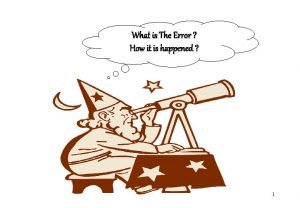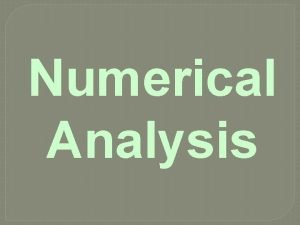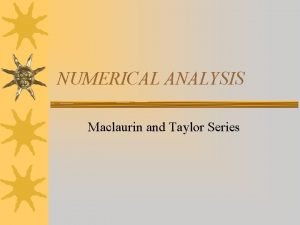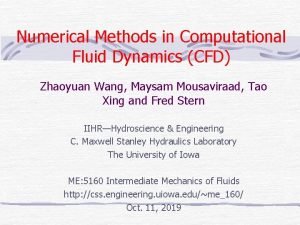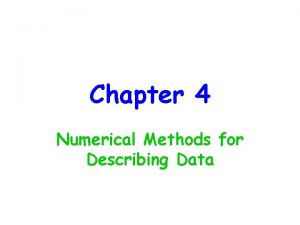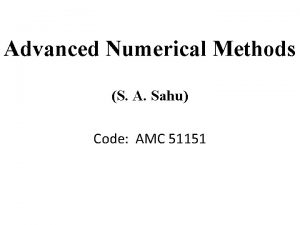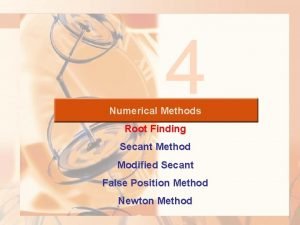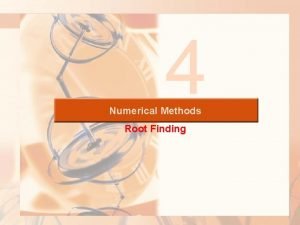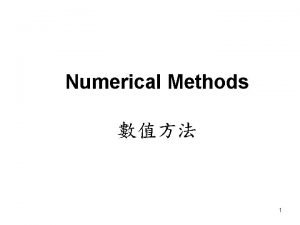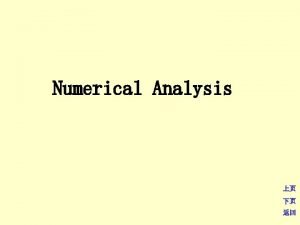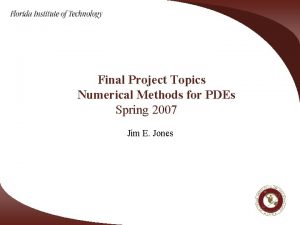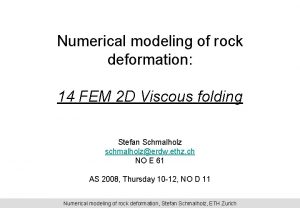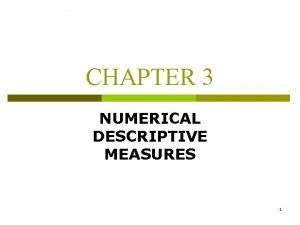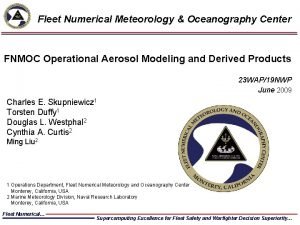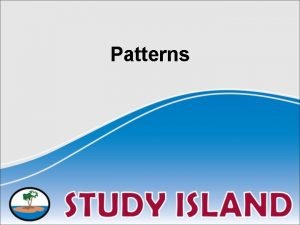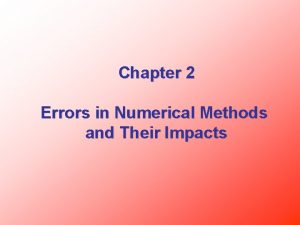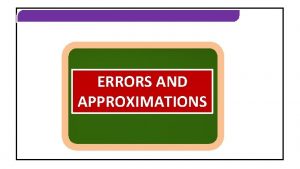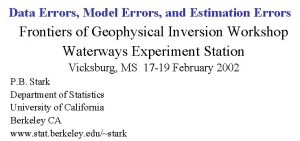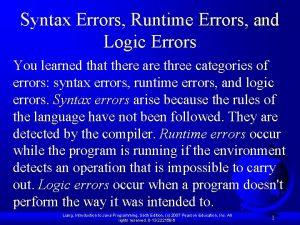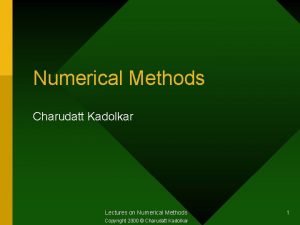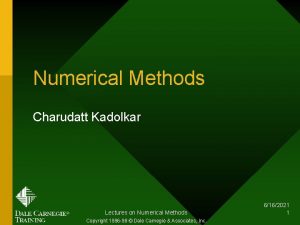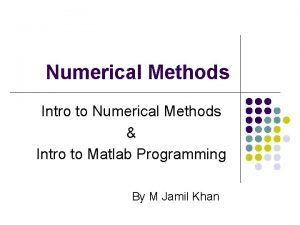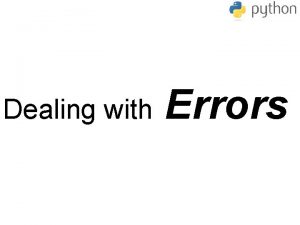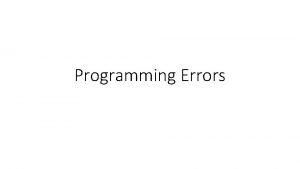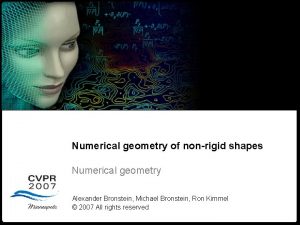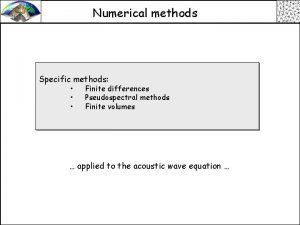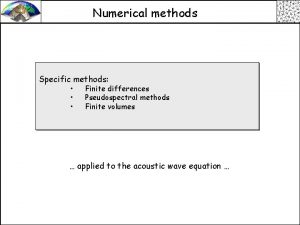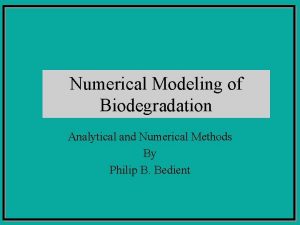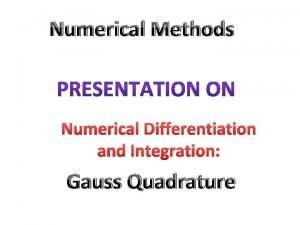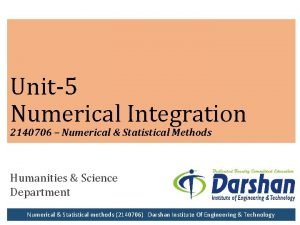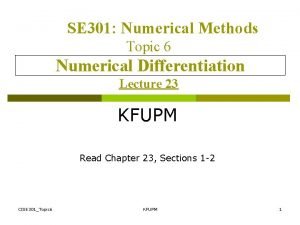Chapter 2 Errors in Numerical Methods and Their























- Slides: 23

Chapter 2 Errors in Numerical Methods and Their Impacts

Objectives • Know finite-word length effect • Know computing errors, their causes and impacts to numerical calculation • Know how to compute the errors • Know the effect of error propagation • Know how to avoid large errors

Content • Introduction • Finite word-length effect (Floating-point number representation) • Error • How to avoid error • Conclusion

Introduction • Why we need to know ? • Computers are great tools, however, without fundamental understanding of engineering problems, they will be useless.

Finite wordlength effect How floating numbers are stored in a computer ? Sign bit Exponent Mantissa Base of the number system used IEEE 64 -bit floating-point number representation

Finite wordlength effect

Finite wordlength effect Ex: 402 C 000000 S Exponent Mantissa 4 0 0 0 0 2 C 0 1 0 0 0 0 10 1 10 0 0 0 0 0 0 0 0 0 0 0 0 S=0 E = Exp-1023=1026 -1023=3 M = 1+0. 11 F = +(1. 11)2 x 23 = (1110)2=14 Check with MATLAB command: “hex 2 num”

Finite wordlength effect(cont’d) Step to convert from decimal number to IEEE stand. Check with MATLAB Use num 2 hex command S Exponent Mantissa 01000000000000000000000000000000 4 0 0 8 0 0 0

Finite wordlength effect(cont’d) How to add 2 numbers : This is done by bit alignment (only mantissa) with refer to the biggest number. Finally, the Mantissa words are added in 2’s system. Example : 1015 Ans: 1. 11000110101111110101001001101 x 21072 -1023 Example : 1 Ans: 1. 0 x 21023 -1023 Example : 1015+1 (show only Mantissa) Ans: 1015 110001101011111101010010011010000000000000000000000001000 Right shift 49 bits 1100011010111111010100100110100000001000 1

Finite wordlength effect(cont’d) 0 10000110000 1100011010111111010100100110100000001000 430 C 6 BF 526340008 How to substract 2 numbers : Complement and done by bit alignment with refer to the biggest number Example : 1015 -1 110001101011111101010010011010000000000000000000000001000 111111111111111111111111100011010111111010100100110011111111000 1015 2’s of 1

Finite wordlength effect(cont’d) 0 10000110000 1100011010111111010100100110011111111000 430 C 6 BF 52633 FFF 8 Will u try with the following problems? -1015 -1 -1015+1

Errors • • Error from numerical algorithm Truncation error Round-off error Overflow/Underflow Loss of significance Negligible addition Error magnification

Errors: Numerical algorithm Numerical integration on Error from exact solution = 0. 1667 Error from exact solution = 0. 0011

Errors: Numerical algorithm Numerical integration on

Errors: Truncation error is resulted from truncation series. Ex. Say x = 1 find exp(x)

Error: Loss of significance Bad subtraction in finite wordlength can create loss of significance. See the following example: Try with x= 1, 100, … 1015

Error: Propagation error Errors are propagated with the four arithmetic Operations. Let the exact values are X and Y, where their related values are x and y, respectively.

Errors • Accuracy. How close is a computed or measured value to the true value • Precision (or reproducibility). How close is a computed or measured value to previously computed or measured values. • Inaccuracy (or bias). A systematic deviation from the actual value. • Imprecision (or uncertainty or variance). Magnitude of scatter.

Errors (cont’d)

Errors (cont’d) Error Definitions True Value = Approximation + Error Et = True value – Approximation (+/-) True error MATLAB Example

Errors (cont’d) What u can see is we can’t estimate the true error for all cases !! (why ? ) So we use the following error definition instead. Approximation error …

Errors (cont’d) Apply approximation error to numerical approach (iterative) (+ / -) Define criteria : - Compute until Meaning that the result is correct at least n significant figures

Errors: Practical
 Types of errors in numerical methods
Types of errors in numerical methods Relative true error formula
Relative true error formula Graphical and numerical methods
Graphical and numerical methods Define backward difference in interpolation
Define backward difference in interpolation Taylor series numerical methods
Taylor series numerical methods Solution on
Solution on What is cfl number in cfd
What is cfl number in cfd Numerical methods for describing data
Numerical methods for describing data Numerical methods of descriptive statistics
Numerical methods of descriptive statistics What is the value of w in laplace everett formula
What is the value of w in laplace everett formula Secant method table
Secant method table Fixed iteration method
Fixed iteration method Numerical methods
Numerical methods Cubic hermite interpolation
Cubic hermite interpolation Numerical methods final project
Numerical methods final project Numerical methods for partial differential equations eth
Numerical methods for partial differential equations eth Differential formula
Differential formula Criminal and addictive thinking worksheets
Criminal and addictive thinking worksheets Wax pattern fabrication pdf
Wax pattern fabrication pdf Variance standard deviation formula
Variance standard deviation formula Two families both alike in dignity
Two families both alike in dignity Fnmoc
Fnmoc Programs that organize analyze and graph numerical data
Programs that organize analyze and graph numerical data Numerical pattern
Numerical pattern

